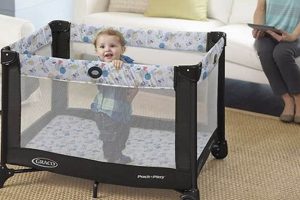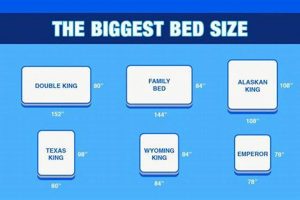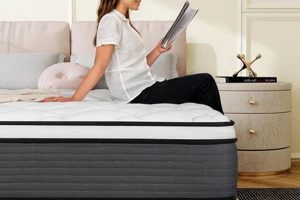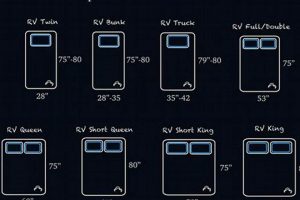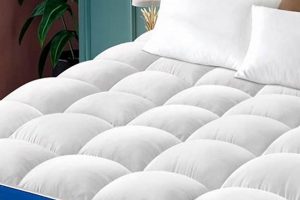Dimensions for sleeping platforms within collapsible recreational vehicles vary considerably. These measurements dictate the appropriate bedding required to ensure comfortable rest. The range can include short queens, full-size, and even twin configurations, dependent on the specific model and manufacturer. For example, one pop-up camper might utilize a 60×74 inch mattress, while another could require a 54×75 inch version.
Accurate determination of bedding dimensions is paramount for optimal comfort and efficient use of space. Selecting the correct size ensures a proper fit, preventing shifting or overhang. Historically, limited standardization existed, prompting consumers to rely on precise measurements or manufacturer specifications. This careful consideration avoids wasted space and maximizes the functionality of the living area.
Understanding the nuances of these sleeping area dimensions allows for informed decisions when selecting replacement bedding or customizing the interior. The following sections will delve into specific size categories, common variations, and considerations for selecting appropriate materials and thicknesses to enhance the overall camping experience.
Selection Guidance for Recreational Vehicle Bedding
This section provides guidance to ensure appropriate bedding selection for folding camping trailers. Accurate measurement and consideration of material properties are critical for comfort and longevity.
Tip 1: Measure the Platform Accurately: Prior to purchasing any mattress, obtain precise interior dimensions of the designated sleeping area. Discrepancies can lead to ill-fitting bedding and discomfort.
Tip 2: Consider Mattress Thickness: Thicker mattresses offer improved comfort, but may impede the folding mechanism of the camper. Refer to the manufacturer’s specifications for maximum allowable thickness.
Tip 3: Evaluate Material Options: Memory foam offers pressure relief and conforms to the body, while innerspring provides firm support. Consider the climate and personal preferences when selecting material.
Tip 4: Explore Customization Possibilities: If standard offerings are unsuitable, consider custom-made options. This ensures a perfect fit and allows for specific material preferences to be addressed.
Tip 5: Factor in Storage Considerations: The ability to easily store the mattress during transit is paramount. Lightweight and compressible materials are preferable. Some mattresses are designed to fold or roll for storage.
Tip 6: Inspect for Mold Resistance: Given the potential for moisture in camping environments, ensure the selected mattress is treated for mold and mildew resistance. Proper ventilation is still recommended.
Tip 7: Research Warranty Information: Review the manufacturer’s warranty to understand coverage for defects or premature wear. This protects the investment over the long term.
Selecting suitable bedding necessitates careful attention to detail. Precise dimensions, appropriate materials, and thoughtful consideration of storage and environmental factors contribute to a comfortable and functional camping experience.
The subsequent sections will further explore specialized features and enhancements available for recreational vehicle mattresses, catering to specific needs and preferences.
1. Width
The horizontal measurement of bedding within a pop-up camper is a critical factor dictating sleeping comfort and efficient use of space. Variations in width among different camper models necessitate careful consideration to ensure an optimal fit.
- Standard Width Categories
Manufacturers often utilize established width categories, such as Twin (approximately 38 inches), Full (approximately 54 inches), and Queen (approximately 60 inches). These classifications provide a general guideline, though specific dimensions may deviate. Understanding these standard categories allows for initial assessment of suitability.
- Impact on Occupancy
Width directly influences the number of occupants the sleeping area can comfortably accommodate. A wider mattress, such as a Queen, typically allows for two adults, while a narrower Twin is more suitable for a single individual. Intended occupancy should guide the selection of an appropriate width.
- Folded Camper Profile
The width of the mattress can impact the overall profile of the camper when folded for transport. Excessive width, particularly when combined with other factors like thickness, might hinder the folding mechanism or increase the stored dimensions of the unit. This interplay between mattress size and folded profile is a relevant consideration.
- Custom Width Considerations
In instances where standard sizes prove inadequate, custom mattress widths may be necessary. This is often the case in vintage or uniquely designed pop-up campers. Customization allows for precise adaptation to the available space, maximizing comfort and functionality.
The various standard and custom dimensions available each affect the suitability of different mattresses. This affects user comfort, the number of possible occupants, the ease of storing the camper, and customization options. A proper dimension match improves the user experience and makes efficient usage of space.
2. Length
The longitudinal dimension of a recreational vehicle mattress significantly affects occupant comfort and spatial efficiency. Insufficient length can cause discomfort for taller individuals, impacting sleep quality. Conversely, excessive length might impede movement within the camper and obstruct the folding mechanism. Determining the appropriate length is therefore crucial for both usability and functionality.
Length considerations are often dictated by the specific pop-up camper model. Some units feature shorter sleeping platforms to maximize living space, while others provide extended berths to accommodate taller occupants. For instance, a common short queen size, often found in these campers, measures 60 inches wide by 74 inches long. Comparing this to a standard queen (60 inches by 80 inches) demonstrates the variance. An individual six feet tall (72 inches) would find a short queen barely adequate. Such size differences directly impact sleeping comfort and should be a primary consideration during mattress selection. Choosing a custom length option allows accommodation of taller users while maintaining camper functionality.
In summary, mattress length represents a pivotal attribute directly impacting comfort and camper utility. Compromises regarding length could lead to persistent discomfort. The correlation between occupant height, available sleeping platform dimensions, and potential obstructions necessitates thorough assessment before acquisition. Careful attention to length guarantees a more comfortable and functional camping experience.
3. Thickness
Mattress thickness is a critical dimension directly influencing comfort, ease of storage, and the overall functionality of a pop-up camper. Improper thickness can impede the folding mechanism, compromise headroom, or result in inadequate support. A thorough understanding of its role is essential when considering bedding options.
- Comfort and Support Levels
Thickness significantly contributes to the level of comfort and support a mattress provides. Thicker mattresses generally offer increased cushioning and better pressure distribution, leading to improved sleep quality. However, this benefit must be balanced against other considerations.
- Impact on Folding Mechanism
The thickness of a mattress directly affects the ability of a pop-up camper to fold and unfold correctly. Exceeding the manufacturer’s recommended maximum thickness can strain the folding mechanism, potentially causing damage or preventing complete closure. This is a primary concern when selecting a replacement mattress.
- Storage and Headroom Considerations
Mattress thickness influences the available headroom inside the camper when set up and the ease with which the mattress can be stored when folded. A thicker mattress may reduce headroom, making the interior feel cramped. Furthermore, it may be more difficult to compress and store securely during travel.
- Material Properties and Durability
Thickness often correlates with the amount and type of material used in the mattress construction, thereby influencing its overall durability and lifespan. Thicker mattresses may contain more layers of foam or a more robust innerspring system, contributing to enhanced longevity. However, material quality is also a crucial factor.
The selection of an appropriate mattress thickness involves a careful balance between comfort, functionality, and storage considerations. While a thicker mattress might offer superior comfort, it could also compromise the camper’s folding mechanism or reduce headroom. Consequently, consulting the manufacturer’s specifications and prioritizing the camper’s operational requirements is paramount.
4. Shape
The geometric configuration of a recreational vehicle mattress is a critical factor when considering compatibility with the internal dimensions of a pop-up camper. Departures from standard rectangular forms often present challenges, impacting fit and overall functionality. Real-world examples frequently involve truncated corners, rounded edges, or unconventional geometries designed to accommodate specific camper layouts. These deviations from standard shapes necessitate careful measurement and assessment to ensure proper integration within the camper’s sleeping platform.
Consider a camper model with wheel well intrusions into the sleeping area. A standard rectangular mattress would not conform to this shape, resulting in wasted space and an unstable sleeping surface. In such cases, a custom-shaped mattress, potentially with cutouts or angled edges, becomes essential. Similarly, pop-up campers with integrated cabinetry or storage units around the bed area may require mattresses with rounded corners to facilitate smooth movement and prevent obstruction. Shape, therefore, is not merely an aesthetic consideration; it directly influences usability and comfort.
The importance of shape is often underestimated, leading to ill-fitting mattresses and compromised sleeping arrangements. Accurately assessing the contours of the sleeping platform and selecting a mattress with a compatible shape is crucial. While standard rectangular options may suffice in some cases, custom-shaped mattresses offer a tailored solution for more complex camper layouts, ensuring both comfort and efficient use of available space. Neglecting this aspect can lead to discomfort and inhibit the camper’s functionality.
5. Customization
Adjustment of bedding dimensions represents a significant element when addressing the spatial limitations and idiosyncratic layouts often encountered within collapsible camping trailers. Standard mattress dimensions may prove inadequate or entirely unsuitable for certain models. Adaptation of length, width, thickness, and shape becomes necessary to optimize the sleeping environment and maintain the camper’s functional characteristics. This tailored approach ensures the bedding conforms precisely to the available space, mitigating potential obstructions and maximizing comfort.
Several factors drive the need for dimensional modification. Irregular sleeping platform shapes, influenced by wheel well intrusions or integrated cabinetry, frequently necessitate non-standard geometries. Occupant height also dictates length considerations; taller individuals require extended mattresses to ensure adequate support. Furthermore, constraints imposed by the folding mechanism often limit permissible thickness. Therefore, altering mattress dimensions presents a solution to address these unique spatial and ergonomic requirements. A specific case involves vintage campers where original bedding standards deviate significantly from contemporary sizes, thus requiring a customized solution. Another scenario involves integrating specific materials or features, such as hypoallergenic fabrics or enhanced support systems, which may necessitate a custom build.
Ultimately, adaptation of bedding dimensions is a crucial aspect for optimizing comfort, functionality, and spatial efficiency within pop-up campers. By addressing the specific needs of the user and the spatial constraints of the camper, dimensional adjustment ensures a more comfortable and practical camping experience. However, cost and lead time should also be considered when choosing this option.
6. Compatibility
The successful integration of a mattress within a pop-up camper hinges on dimensional alignment with the designated sleeping platform and the camper’s operational mechanisms. Bedding dimensions must conform to spatial constraints to avoid inhibiting the camper’s functionality. This section details key facets of dimensional alignment.
- Platform Dimensions and Mattress Fit
The physical dimensions of the sleeping platform are the primary determinant of mattress compatibility. Length, width, and any non-standard shapes (e.g., rounded corners, cutouts) must be accurately measured. A mattress that exceeds these dimensions will not fit properly, leading to discomfort and potential damage to the camper. Conversely, a mattress that is too small results in wasted space and an unstable sleeping surface.
- Folded Profile and Storage Constraints
The folded profile of the mattress directly impacts the camper’s ability to collapse properly for transport and storage. A mattress that is too thick or constructed of non-compressible materials may prevent the camper from fully closing or create excessive stress on the folding mechanism. Weight considerations are also important, a very heavy mattress may add too much weight to the camper, which is not ideal for smaller pop up campers.
- Weight Distribution and Structural Integrity
The weight of the mattress and its distribution across the sleeping platform influence the structural integrity of the camper. Excessive weight or uneven distribution can compromise the support system and potentially lead to damage. It is crucial to adhere to the manufacturer’s specified weight limits for the sleeping platform.
- Material Properties and Environmental Factors
The materials from which the mattress is constructed should be compatible with the environment inside the pop-up camper. Breathable fabrics are essential to minimize moisture buildup, which can lead to mold and mildew growth. Similarly, the materials should be resistant to temperature fluctuations and UV exposure to prevent degradation over time.
Adherence to these dimensional, material, and operational considerations dictates compatibility between the mattress and the pop-up camper. Deviation from these guidelines can compromise comfort, functionality, and the longevity of both the mattress and the camper itself. Proper attention to these compatibility factors ensures a functional and safe recreational vehicle.
Frequently Asked Questions
This section addresses common inquiries regarding the dimensions of bedding for collapsible recreational vehicles. The information provided aims to clarify typical specifications and assist in informed purchasing decisions.
Question 1: What are the typical dimensions for a pop up camper mattress?
Standard measurements vary significantly depending on the camper model. Common sizes include short queen (60″ x 74″), full (54″ x 75″), and twin (approximately 38″ x 75″). Precise measurements should always be taken to ensure proper fit.
Question 2: How does mattress thickness affect the folding mechanism of the camper?
Excessive mattress thickness can impede the folding mechanism, potentially causing damage or preventing complete closure. Refer to the camper manufacturer’s specifications for the maximum allowable mattress thickness.
Question 3: Can a standard residential mattress be used in a pop up camper?
Standard residential mattresses are generally not recommended due to their weight and thickness. These characteristics can exceed the camper’s structural limitations and inhibit the folding process.
Question 4: What should be considered when selecting a mattress material for a pop up camper?
Material selection should prioritize breathability, moisture resistance, and compressibility. Memory foam, while comfortable, can retain moisture. Innerspring mattresses should be lightweight and offer adequate support. Consider materials treated for mold and mildew resistance.
Question 5: Are custom-sized mattresses available for pop up campers?
Yes, custom-sized mattresses can be manufactured to accommodate unique platform dimensions or specific comfort preferences. This option offers a tailored solution for campers with non-standard layouts.
Question 6: How should a pop up camper mattress be stored when not in use?
Mattresses should be stored in a dry, well-ventilated area to prevent mold and mildew growth. Compressing or rolling the mattress, if feasible, can reduce storage space requirements. Some mattresses are specifically designed to fold for easier storage.
The dimensions of the bedding are important when finding compatible accessories such as mattress toppers and mattress protectors.
This concludes the frequently asked questions section. The following section will address maintenance considerations.
Concluding Remarks on Pop Up Camper Mattress Sizes
This exposition has detailed the critical nature of dimensional accuracy when selecting bedding for collapsible camping trailers. The appropriate length, width, thickness, and shape are essential for ensuring both user comfort and the continued functionality of the camper itself. Deviation from recommended dimensions or a failure to account for material properties can lead to discomfort, damage, and a compromised camping experience. The necessity of meticulous measurement and a comprehensive understanding of spatial constraints cannot be overstated.
Therefore, prospective buyers and current owners are urged to prioritize accurate assessment and informed decision-making when addressing bedding replacement or upgrades. The long-term benefits of a properly fitted and thoughtfully selected mattress far outweigh the potential costs associated with neglecting these critical considerations. Continued adherence to these principles will ensure a comfortable and well-maintained recreational vehicle.



